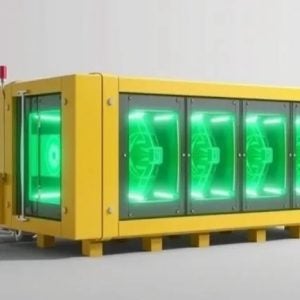The International Atomic Energy Agency (IAEA) plans to send its next nuclear safety, security and safeguards mission to Ukraine’s Chernobyl NPP in the coming weeks, Director General Rafael Mariano Grossi said on 17 May.
“Our on-the-ground assistance will concentrate on radiation protection, safety of waste management, and nuclear security,” he said in a video statement about the IAEA’s efforts to help ensure the safety and security of Ukraine’s nuclear facilities and maintain its safeguards activities during the current military conflict. “The safety and security of Ukraine’s nuclear facilities remains my top priority,” he said.
Director General Grossi personally led the IAEA’s previous two assistance missions to Ukraine, travelling to the South Ukraine NPP in late March and to Chernobyl about a month later. The next mission to Chernobyl will consist of IAEA safety and security experts as well as safeguards inspectors. They will continue their work from the previous visit to the site of the 1986 accident, which was occupied by Russian forces for five weeks before they withdraw on 31 March.
Grossi is now also focused on agreeing, organising and leading an IAEA mission to the Russian-controlled Zaporozhye NPP, to carry out important nuclear safety, security and safeguards work at this site.
“The IAEA is perfectly positioned to ensure Ukraine gets what it needs efficiently and quickly,” he said. “At the IAEA we never stop, not even for a single minute. That’s true today and will be as long as Ukraine needs our assistance.”
However, Petro Kotin, acting head of Ukraine’s nuclear utility Energoatom continues to criticise the IAEA. In a lengthy interview with Vesti.ua on 13 May he said: “All we hear from them now is, ‘Our concern is very high’. Of course, this is not enough for us. We would like to see a meeting of the IAEA Board of Governors, which will adopt a resolution with appropriate measures against Russia. We have already submitted a corresponding application.” In an earlier interview with the Tyzhden newspaper on 3 May, he described the Agency as “very reticent”. On the situation in Zaporozhye he said: “The IAEA must react harshly to all this, but it is doing nothing. The IAEA and its director, Rafael Mariano Grossi, have taken a very compromising position. He says the IAEA is not dealing with political issues, but only technical ones. The technical issues in this case depend on a political solution, namely the liberation of the station from the presence of the military.”
Although Grossi has made clear repeatedly that he wishes to visit the plant to provide any support deemed necessary, Kotin would appear to be opposing this. In an earlier interview with Interfax on 14 April, Kotin when asked whether the IAEA would visit Zaporozhye while the Russian troops were in control, he said: “I will not allow it. We will not go for that, it is clear.”
Ukraine separately informed the IAEA on 17 May that there had been no significant developments related to nuclear safety and security in the country over the past 24 hours. Regarding the operating reactors at four NPPs, Ukraine said eight are currently connected to the grid, including two at the Zaporozhye, three at Rovno, two at South Ukraine, and one at the Khmelnitsky. The seven other reactors are shut down for regular maintenance or held in reserve. Safety systems remain operational at all four NPPs, which continue to have off-site power available. In relation to safeguards, IAEA headquarters is receiving remote safeguards data from the Chernobyl NPP as well as from the four operating NPPs.






